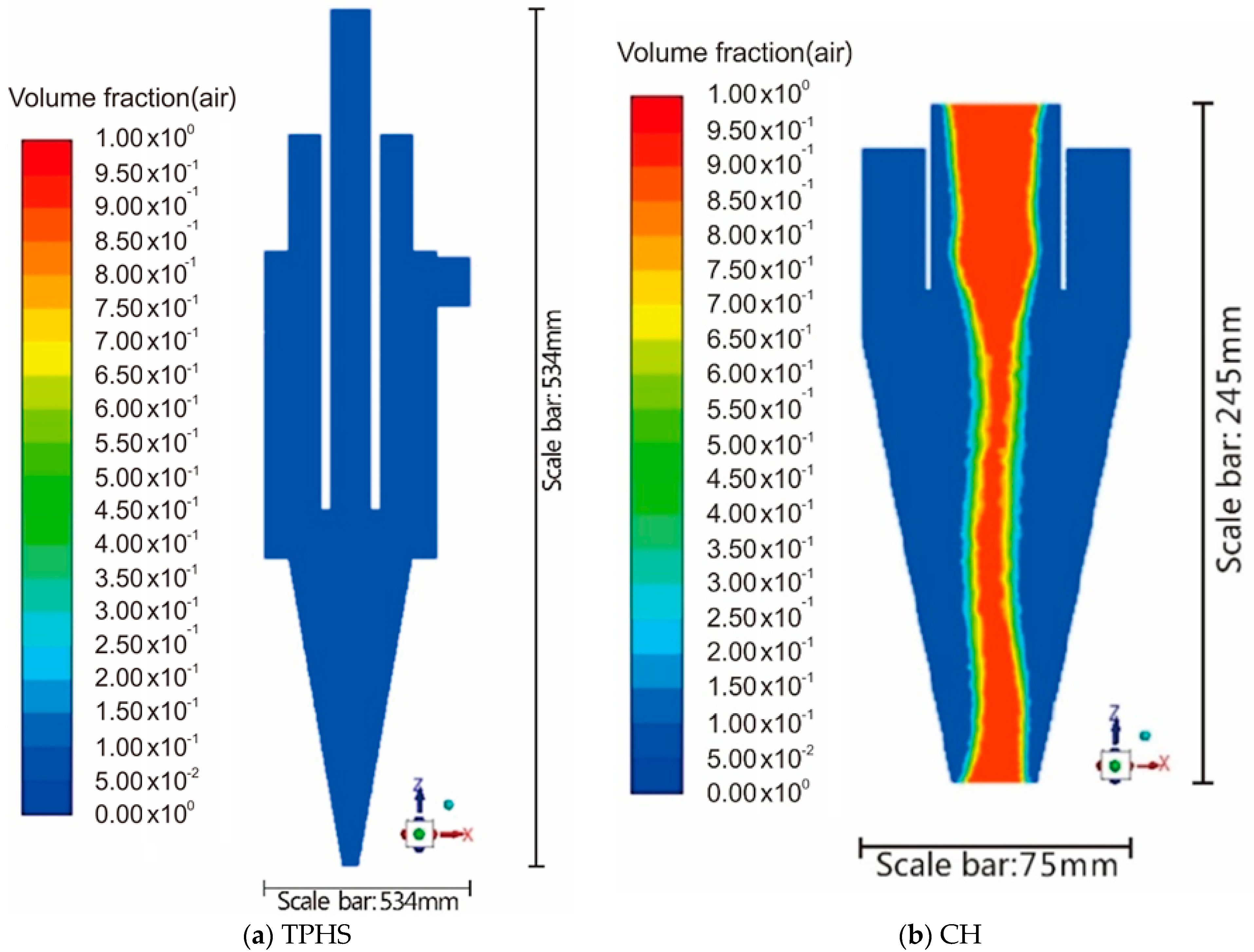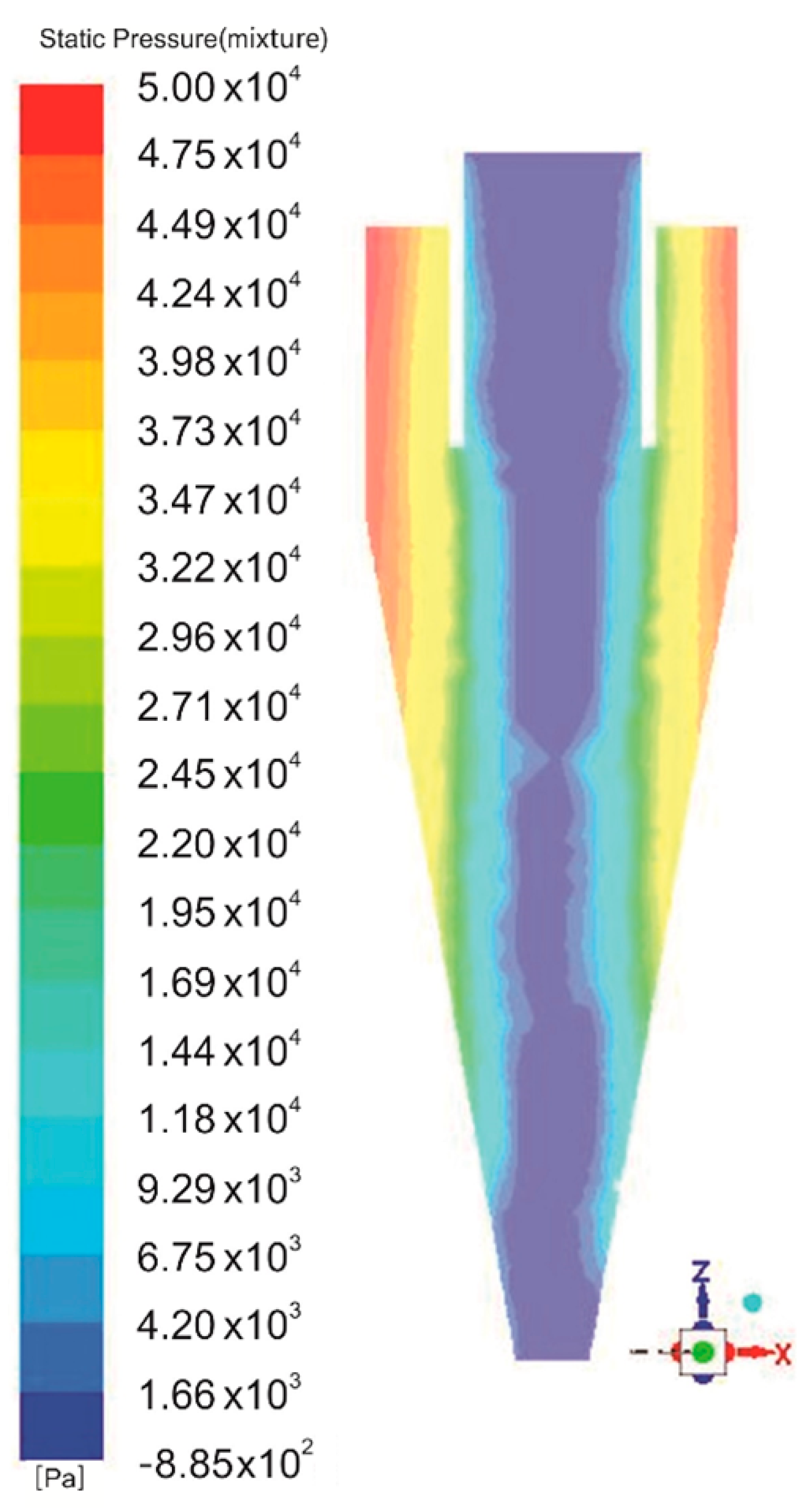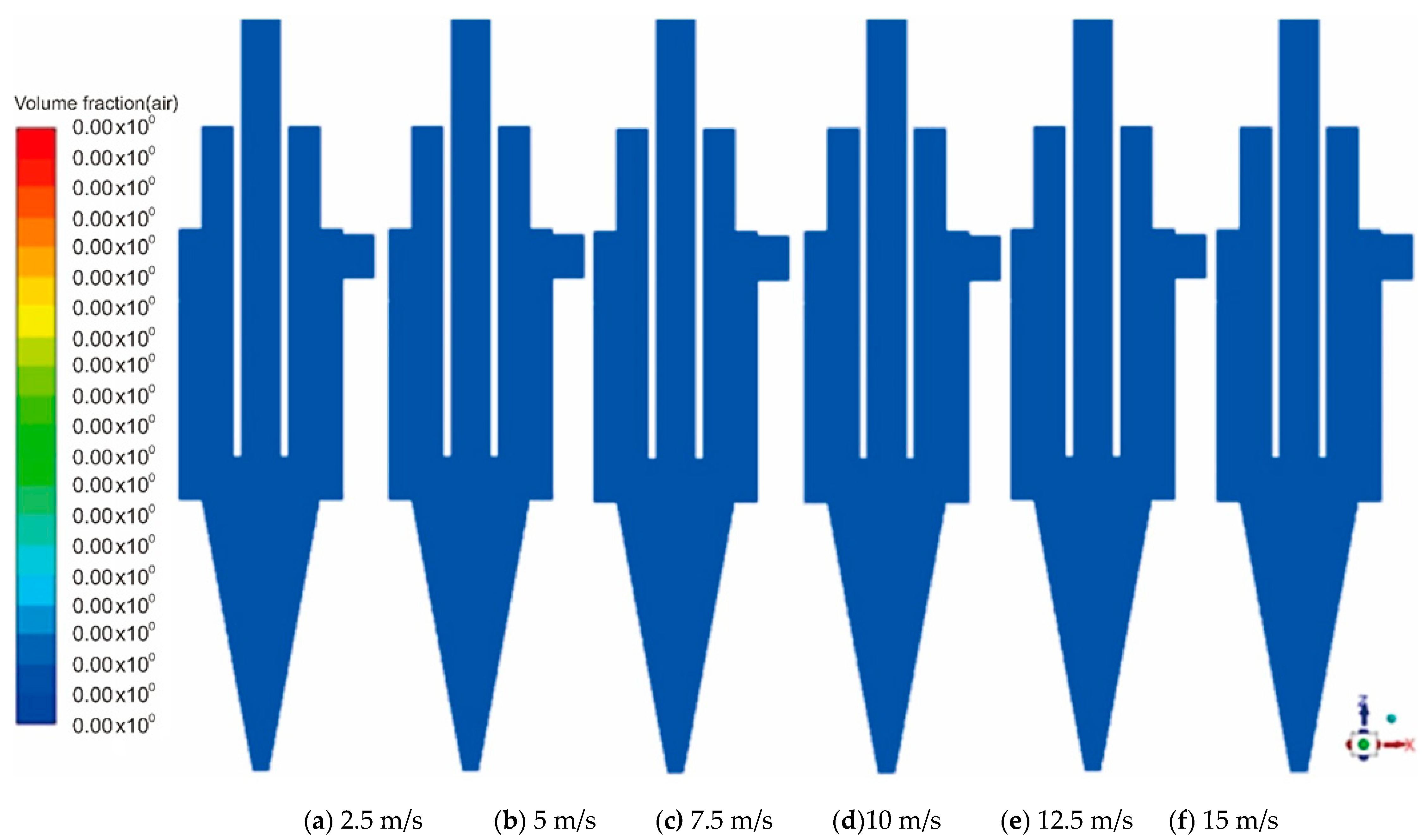Mechanism of the Absent Air Column in Three Products Hydrocyclone Screen (TPHS): Experiment and Simulation
Abstract
:1. Introduction
- comprehensively describe the development process of flow field in TPHS using the simulation and experiment methods.
- systematically explore the mechanism of the absent air column in the innovative cyclone through the numerical comparison between TPHS and CH.
2. Methodology
2.1. Experimental Facilities
2.2. Numerical Model
3. Results and Discussion
3.1. Development Process of Flow Field in Three Products Hydrocyclone Screen (TPHS)
3.2. Mechanism of the Absent Air Column in TPHS
4. Conclusions
- (1)
- both CFD simulation and physical experiment under same conditions display the coincident flow field evolution. As the water was introduced along the tangential direction into the TPHS, the liquid phase spiraled downward due to the effects of feed chamber wall and gravity acceleration; until the liquid fluid moved near the cylindrical screen, it passed through the sieves to generate the screen underflow; however, due to the small underflow, the air volume fraction inside the TPHS rapidly fell from 1 to 0; finally, the water phase filled the TPHS, which indicated the air column was entirely removed.
- (2)
- the distribution comparison of air volume fraction reveals that the air column can be clearly observed in CH, while the opposite tendency (via the absent air core) was obtained in TPHS; further, the distribution comparison of static pressure demonstrates that the positive and negative static pressure can be detected in TPHS and CH, respectively, in the center region along the z-axis; this means that in the TPHS the air cannot be sucked or released to form the air core; this trend is attributed to the added cylindrical screen which optimized the flow field distribution inside the TPHS.
- (3)
- the contours of air column fraction in the TPHS under different feed velocity represent the absent air core (i.e., the air phase fraction of 0), moreover the static pressure distribution with the increasing axial depth reveals that the absent air core can be attributed to the positive static pressure distribution.
Author Contributions
Funding
Institutional Review Board Statement
Informed Consent Statement
Data Availability Statement
Conflicts of Interest
References
- Bradley, D. The Hydrocyclone: International Series of Monographs in Chemical Engineering; Elsevier: Amsterdam, The Netherlands, 2013. [Google Scholar]
- Razmi, H.; Goharrizi, A.S.; Mohebbi, A. CFD simulation of an industrial hydrocyclone based on multiphase particle in cell (MPPIC) method. Sep. Purif. Technol. 2018, 209, 851–862. [Google Scholar] [CrossRef]
- Ghodrat, M.; Qi, Z.; Kuang, S.; Ji, L.; Yu, A. Computational investigation of the effect of particle density on the multiphase flows and performance of hydrocyclone. Miner. Eng. 2016, 90, 55–69. [Google Scholar] [CrossRef]
- Feng, B.; Jiao, X.; Wang, H.; Peng, J.; Yang, G. Improving the separation of chalcopyrite and galena by surface oxidation using hydroxyethyl cellulose as depressant—ScienceDirect. Miner. Eng. 2021, 160, 106657. [Google Scholar]
- Chen, L.; Liu, W.; Zeng, J.; Ren, P. Quantitative investigation on magnetic capture of single wires in pulsating HGMS. Powder Technol. 2017, 313, 54–59. [Google Scholar] [CrossRef]
- Obeng, D.; Morrell, S. The JK three-product cyclone—performance and potential applications. Int. J. Miner Process. 2003, 69, 129–142. [Google Scholar] [CrossRef]
- Salvador, F.F.; Barrozo, M.A.; Vieira, L.G. Filtering cylindrical–conical hydrocyclone. Particuology 2019, 47, 54–62. [Google Scholar] [CrossRef]
- Jianzhong, C.; Lijuan, S.; Chuanzhen, W. Desliming performance of the three-product cyclone classification screen. J. China Univ. Min. Technol. 2016, 45, 807–813. [Google Scholar]
- Wang, C.; Chen, J.; Shen, L.; Hoque, M.M.; Ge, L.; Evans, G.M. Inclusion of screening to remove fish-hook effect in the three products hydro-cyclone screen (TPHS). Miner. Eng. 2018, 122, 156–164. [Google Scholar] [CrossRef]
- Wang, C.; Sun, X.; Shen, L.; Wang, G. Analysis and Prediction of Influencing Parameters on the Coal Classification Performance of a Novel Three Products Hydrocyclone Screen (TPHS) Based on Grey System Theory. Processes 2020, 8, 974. [Google Scholar] [CrossRef]
- Kraipech, W.; Nowakowski, A.; Dyakowski, T.; Suksangpanomrung, A. An investigation of the effect of the particle-fluid and particle-particle interactions on the flow within a hydrocyclone. Chem. Eng. J. 2005, 111, 189–197. [Google Scholar] [CrossRef]
- Majumder, A.; Shah, H.; Shukla, P.; Barnwal, J. Effect of operating variables on shape of “fish-hook” curves in cyclones. Miner. Eng. 2007, 20, 204–206. [Google Scholar] [CrossRef]
- Wang, B.; Chu, K.W.; Yu, A.B.; Vince, A. Computational investigation of the mechanisms of the "breakaway" effect in a dense medium cyclone. Miner. Eng. 2014, 62, 111–119. [Google Scholar]
- Zhu, X.-B.; Xu, N.-X.; Liu, L.-H. Application of three-product cyclone sizing screen in classification and thickening of slime in Xuehu coal preparation plant. Coal Prep. Technol. 2012, 1, 12. [Google Scholar]
- Li, Q.; Wang, J.; Jin, Y. Performance evaluation of a new cyclone separator—Part II simulation results. Sep. Purif. Technol. 2016, 160, 112–116. [Google Scholar]
- Wang, C.; Chen, J.; Shen, L.; Ge, L. Study of flow behaviour in a three products hydrocyclone screen: Numerical simulation and experimental validation. Physicochem. Probl. Miner Process 2019, 55, 879–895. [Google Scholar]
- Zou, J.; Wang, C.X.; Ji, C. Experimental study on the air core in a hydrocyclone. Dry. Technol. 2016, 34, 854–860. [Google Scholar] [CrossRef]
- Chu, L.-Y.; Yu, W.; Wang, G.-J.; Zhou, X.-T.; Chen, W.-M.; Dai, G.-Q. Enhancement of hydrocyclone separation performance by eliminating the air core. Chem. Eng. Process. Process Intensif. 2004, 43, 1441–1448. [Google Scholar] [CrossRef]
- Chu, L.Y.; Chen, W.M.; Lee, X.Z. Enhancement of hydrocyclone performance by controlling the inside turbulence structure. Chem. Eng. Sci. 2002, 57, 207–212. [Google Scholar] [CrossRef]
- Ke, R.; Shingote, C.; Kadambi, J.R.; Furlan, J.; Visintainer, R. Experimental and Numerical Investigations of the Fluid Flow in a Hydroclyclone with an Air Core. Min. Metall. Explor. 2019, 37, 277–286. [Google Scholar] [CrossRef]
- Jirun, X.; Qian, L.; Jicun, Q. Studying the flow field in a hydrocyclone with no forced vortex: Part I: Average velocity. Filtr. Sep. 1990, 27, 276–278. [Google Scholar] [CrossRef]
- Hirt, C.W.; Nichols, B.D. Volume of fluid (VOF) method for the dynamics of free boundaries. J. Comput. Phys. 1981, 39, 201–225. [Google Scholar] [CrossRef]
- Gibson, M.; Launder, B. Ground effects on pressure fluctuations in the atmospheric boundary layer. J. Fluid Mech. 1978, 86, 491–511. [Google Scholar] [CrossRef]
- Launder, B.; Reece, G.J.; Rodi, W. Progress in the development of a Reynolds-stress turbulence closure. J. Fluid Mech. 1975, 68, 537–566. [Google Scholar] [CrossRef] [Green Version]
- Launder, B.E. Second-moment closure: Present… and future? Int. J. Heat Fluid Flow 1989, 10, 282–300. [Google Scholar] [CrossRef]
- Yan, X.; Wang, L.; Cao, Y.; Liu, J. Effect of cone angles on single-phase flow of a laboratory cyclonic-static micro-bubble flotation column: PIV measurement and CFD simulations. Sep. Purif. Technol. 2015, 149, 308–314. [Google Scholar]
- Dyakowski, T.; Williams, R.A. Prediction of Air-Core Size and Shape in a Hydrocyclone. Int. J. Miner. Process. 1995, 43, 1–14. [Google Scholar] [CrossRef]
- Nowakowski, A.F.; Cullivan, J.C.; Williams, R.A.; Dyakowski, T. Application of CFD to modelling of the flow in hydrocyclones. Is this a realizable option or still a research challenge? Miner. Eng. 2004, 17, 661–669. [Google Scholar] [CrossRef]
- Doby, M.J.; Nowakowski, A.F.; Yiu, I.; Dyakowski, T. Understanding air core formation in hydrocyclones by studying pressure distribution as a function of viscosity. Int. J. Miner. Process. 2008, 86, 18–25. [Google Scholar] [CrossRef]
- Cullivan, J.C.; Williams, R.A.; Dyakowski, T.; Cross, C.R. New understanding of a hydrocyclone flow field and separation mechanism from computational fluid dynamics. Miner. Eng. 2004, 17, 651–660. [Google Scholar] [CrossRef]
- Neesse, T.; Dueck, J. Air core formation in the hydrocyclone. Miner. Eng. 2007, 20, 349–354. [Google Scholar] [CrossRef]











| Items | 75-mm TPHS | 75-mm CH |
|---|---|---|
| Diameter of cylindrical screen | 75 mm | N/A |
| Diameter of cylindrical envelope | 105 mm | 75 mm |
| Aperture size | 0.65 mm | N/A |
| Thickness of screen bar | 5 mm | N/A |
| Width of screen bar | 3.25 mm | N/A |
| Hydraulic diameter of inlet | 12.54 mm | 21 mm |
| Length of feed chamber | 70 mm | N/A |
| Length of cylindrical envelope | 185 mm | 60 mm |
| Length of vortex finder | 300 mm | 60 mm |
| Insertion length of overflow pipe | 185 | 45 mm |
| Diameter of vortex finder | 25 mm | 36 mm |
| Diameter of screen underflow outlet | 30 mm | N/A |
| Angle of cone | 20° | 20° |
| Diameter of underflow | 10 mm | 15 mm |
Publisher’s Note: MDPI stays neutral with regard to jurisdictional claims in published maps and institutional affiliations. |
© 2021 by the authors. Licensee MDPI, Basel, Switzerland. This article is an open access article distributed under the terms and conditions of the Creative Commons Attribution (CC BY) license (http://creativecommons.org/licenses/by/4.0/).
Share and Cite
Wang, C.; Yu, A.; Zhu, Z.; Liu, H.; Khan, M.S. Mechanism of the Absent Air Column in Three Products Hydrocyclone Screen (TPHS): Experiment and Simulation. Processes 2021, 9, 431. https://doi.org/10.3390/pr9030431
Wang C, Yu A, Zhu Z, Liu H, Khan MS. Mechanism of the Absent Air Column in Three Products Hydrocyclone Screen (TPHS): Experiment and Simulation. Processes. 2021; 9(3):431. https://doi.org/10.3390/pr9030431
Chicago/Turabian StyleWang, Chuanzhen, Anghong Yu, Zaisheng Zhu, Haizeng Liu, and Md. Shakhaoath Khan. 2021. "Mechanism of the Absent Air Column in Three Products Hydrocyclone Screen (TPHS): Experiment and Simulation" Processes 9, no. 3: 431. https://doi.org/10.3390/pr9030431








